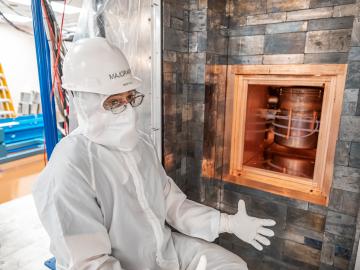
Filter News
Area of Research
- (-) Materials (102)
- (-) National Security (24)
- Advanced Manufacturing (5)
- Biology and Environment (58)
- Biology and Soft Matter (1)
- Building Technologies (2)
- Computational Biology (1)
- Computational Engineering (3)
- Computer Science (15)
- Electricity and Smart Grid (1)
- Energy Science (149)
- Energy Sciences (1)
- Functional Materials for Energy (1)
- Fusion and Fission (12)
- Fusion Energy (2)
- Isotope Development and Production (1)
- Isotopes (4)
- Materials for Computing (18)
- Mathematics (1)
- Neutron Science (34)
- Nuclear Science and Technology (10)
- Quantum information Science (7)
- Supercomputing (126)
- Transportation Systems (2)
News Topics
- (-) Chemical Sciences (32)
- (-) Computer Science (33)
- (-) Frontier (3)
- (-) Physics (28)
- (-) Polymers (17)
- (-) Space Exploration (2)
- (-) Transportation (16)
- 3-D Printing/Advanced Manufacturing (25)
- Advanced Reactors (5)
- Artificial Intelligence (21)
- Big Data (7)
- Bioenergy (14)
- Biology (8)
- Biomedical (8)
- Biotechnology (1)
- Buildings (6)
- Clean Water (3)
- Composites (9)
- Coronavirus (6)
- Critical Materials (13)
- Cybersecurity (21)
- Energy Storage (35)
- Environment (20)
- Exascale Computing (2)
- Fusion (8)
- Grid (11)
- High-Performance Computing (8)
- Irradiation (1)
- Isotopes (13)
- ITER (1)
- Machine Learning (16)
- Materials (74)
- Materials Science (78)
- Mathematics (1)
- Microscopy (27)
- Molten Salt (3)
- Nanotechnology (39)
- National Security (35)
- Neutron Science (35)
- Nuclear Energy (21)
- Partnerships (15)
- Quantum Computing (3)
- Quantum Science (12)
- Security (11)
- Simulation (2)
- Summit (4)
Media Contacts

Chemist Jeff Foster is looking for ways to control sequencing in polymers that could result in designer molecules to benefit a variety of industries, including medicine and energy.

The old photos show her casually writing data in a logbook with stacks of lead bricks nearby, or sealing a vacuum chamber with a wrench. ORNL researcher Frances Pleasonton was instrumental in some of the earliest explorations of the properties of the neutron as the X-10 Site was finding its postwar footing as a research lab.

Scientists at ORNL developed a competitive, eco-friendly alternative made without harmful blowing agents.

Benjamin Manard has been named to the editorial board of Applied Spectroscopy Practica, serving as an associate editor.

For nearly six years, the Majorana Demonstrator quietly listened to the universe. Nearly a mile underground at the Sanford Underground Research Facility, or SURF, in Lead, South Dakota, the experiment collected data that could answer one of the most perplexing questions in physics: Why is the universe filled with something instead of nothing?

U2opia Technology, a consortium of technology and administrative executives with extensive experience in both industry and defense, has exclusively licensed two technologies from ORNL that offer a new method for advanced cybersecurity monitoring in real time.

Researchers at ORNL zoomed in on molecules designed to recover critical materials via liquid-liquid extraction — a method used by industry to separate chemically similar elements.

Critical Materials Institute researchers at Oak Ridge National Laboratory and Arizona State University studied the mineral monazite, an important source of rare-earth elements, to enhance methods of recovering critical materials for energy, defense and manufacturing applications.

Seven scientists at the Department of Energy’s Oak Ridge National Laboratory have been named Battelle Distinguished Inventors, in recognition of their obtaining 14 or more patents during their careers at the lab.

Scientists at the Department of Energy’s Oak Ridge National Laboratory are leading a new project to ensure that the fastest supercomputers can keep up with big data from high energy physics research.


